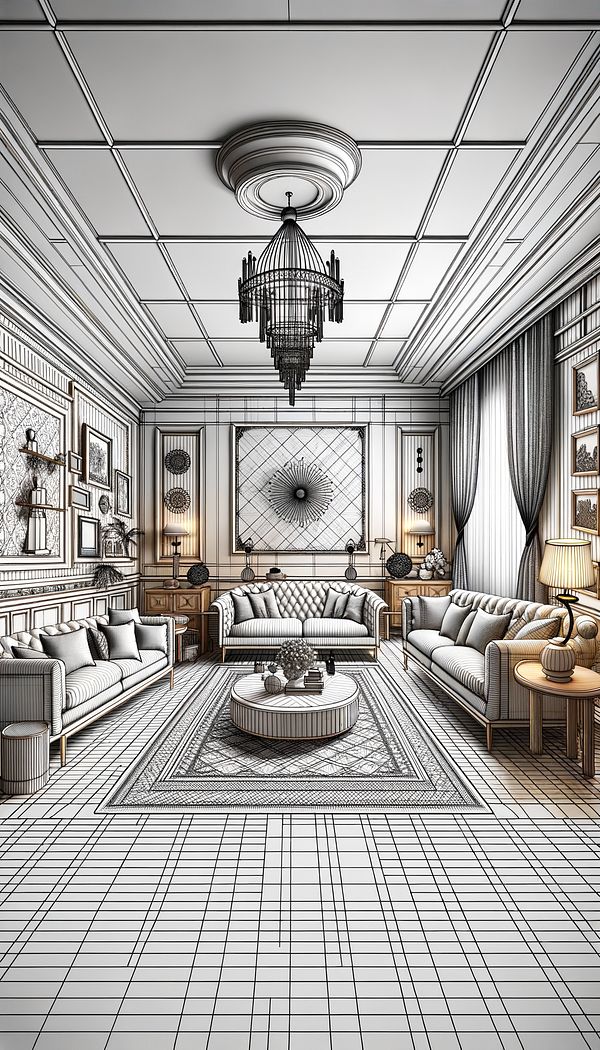What is Line?
Line in interior design refers to the continuous mark or edge that defines shapes and forms, and guides the eye movement within a space.
Description
In the world of interior design, the concept of line plays a pivotal role in creating harmony, contrast, and unity within a space. It's essentially the foundation upon which other design elements such as color and patterns, textiles and upholstery, and furniture types are built upon. Lines can be visible, like the sharp edges of a table or the smooth curve of a sofa, or they can be implied, guiding the eye through arrangement and positioning.
Lines come in a variety of forms - horizontal, vertical, diagonal, and curved. Each type of line has its own effect on the feel and aesthetic of a space. Horizontal lines, for instance, tend to evoke a sense of stability and calmness, while vertical lines can make a room feel taller and more majestic. Diagonal lines add dynamism and movement, and curved lines introduce softness and comfort. By understanding the impact of each line type, interior designers craft spaces that not only look beautiful but feel instinctively right.
The strategic use of lines can significantly influence the perception of a space. For example, incorporating vertical lines through elements like tall bookcases or high curtains can create an illusion of height in rooms with low ceilings. Similarly, horizontal lines found in long sofas or wide tables can make a room appear more spacious. The balance and interaction between different forms of lines contribute to the overall space planning and layout, ensuring the signature look and feel of the designed space cater to the desired ambiance and functionality.
Usage
In a modern living room, the use of horizontal lines in the form of a low, wide sofa and a long coffee table creates a feeling of spaciousness and relaxation. Alternatively, in a small bedroom, vertical lines employed through the use of a tall, narrow wardrobe and long curtains can make the space appear larger and more elegant. In both examples, the thoughtful application of lines complements other design elements like color, texture, and lighting, creating harmonious and aesthetically pleasing interiors.
FAQs
-
How do lines affect the mood of a room?
Lines can have a significant impact on the mood of a room. Horizontal lines convey stability and tranquility, making a space feel restful. Vertical lines evoke a sense of elegance and grandeur, potentially making a room feel more formal. Diagonal lines introduce a sense of movement and excitement, while curved lines add a touch of softness and comfort. The type of lines used can influence how a room feels and how it's perceived.
-
Can the use of lines improve the functionality of a space?
Yes, the strategic use of lines can enhance the functionality of a space. For example, horizontal lines in furniture and layout can aid in creating clear pathways and define functional areas within a room, making it more navigable and user-friendly. Vertical lines can help in maximizing space utilization, making a room feel larger and more open.
-
Are lines only important in modern interior design?
While lines are often associated with modern and minimalist design due to their clean and simple aesthetic, they play a crucial role in all types of interior design styles. From traditional to contemporary, the use of lines helps to define spaces, create harmony, and establish a visual narrative, regardless of the design style.
Practical Application
To effectively use lines in interior design, start by identifying the desired effect or mood for the space. Consider incorporating various types of lines through furniture, architectural elements, and decor to achieve the intended ambiance. Pay attention to balance and proportion to ensure the lines complement rather than compete with other design elements. Remember, the thoughtful application of lines can transform a space, enhancing both its aesthetics and functionality.
-
Furniture Types599 articles
-
Space Planning & Layout134 articles
-
Decorating Principles & Elements330 articles
-
Color & Patterns154 articles
-
Textiles & Upholstery252 articles
-
EggshellEggshell is a type of paint finish that has a soft, low-sheen appearance.
-
FutonA futon is a multifunctional piece of furniture that can serve as both a sofa and a bed.
-
FrameIn interior design, frame refers to a structural element that surrounds or supports objects such as artwork, mirrors, or doors.
-
Channel BackA channel back is a type of upholstery design characterized by vertical grooves or channels.
-
Accessory Dwelling UnitAn Accessory Dwelling Unit (ADU) is a secondary housing unit on a single residential lot.
